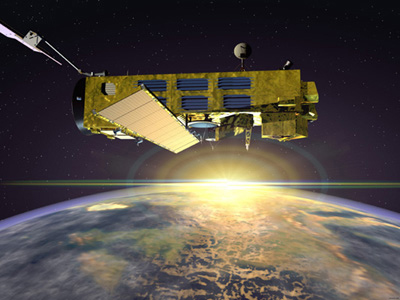Huge Satellite Loses Contact with Earth

The European Space Agency is struggling to restore contact with its massive satellite Envisat, the largest civilian Earth-observation satellite ever to fly in space.
The troubles began on April 8, when Envisat unexpectedly stopped phoning home. The communications dropout was noticed when flight controllers did not receive an expected transmission from the satellite when it flew over a ground station in Kiruna, Sweden.
The 10-year-old spacecraft weighs about 17,600 pounds (8,000 kilograms) and is the size of a school bus. It has been a prolific source of Earth-observation imagery, so much so that after its successful five-year mission ended it kept going for an extra five years, ESA officials said.
It is the "world's most complex Earth-observation satellite" that has performed above and beyond its original mission, they added. [Video: Over Earth – Envisat's View]
ESA officials immediately declared a spacecraft emergency once contact was lost and began listening for any transmissions from the silent spacecraft, but so far Envisat has been mum. The satellite, however, is not falling out of space.
"While it is known that Envisat remains in a stable orbit around Earth, efforts to resume contact with the satellite have, so far, not been successful," ESA officials said in a statement released Thursday (April 12).
Envisat orbits the Earth at an altitude of about 486 miles (782 kilometers). It completes one trip around the planet every 100 minutes and has completed more than 50,000 orbits since its launch in 2002.
Get the Space.com Newsletter
Breaking space news, the latest updates on rocket launches, skywatching events and more!
The $2.9 billion satellite is one of the most expensive ever built and the largest non-military satellite to observe the Earth from orbit. It is about 30 feet long (10 meters) and 16 feet wide (5 m), with a huge solar array that is about 16 feet wide (5 m) and 46 feet long (14 m), according to an ESA description.
In 2010, orbital debris experts said that the sheer size of the satellite makes Envisat a major space junk concern once its mission ends. At the time, scientists said the satellite would likely stay in orbit for about 150 years, barring unforeseen circumstances. However, it is still too early to know if Envisat is permanently lost or can be recovered in the coming days.
Envisat's primary mission has been to study the Earth with 10 sensitive instruments to map the planet's land, oceans, ice and atmosphere in extreme detail. It has been used by more than 4,000 projects representing 70 different countries.
The spacecraft was slated to be retired in 2013, when a new series of Earth-watching satellites — called GMES Sentinel — is scheduled to launch.
"The interruption of the Envisat service shows that the launch of the GMES Sentinel satellites, which are planned to replace Envisat, becomes urgent," said Volker Liebig, director of ESA's Earth Observation Program.
You can follow SPACE.com Managing Editor Tariq Malik on Twitter @tariqjmalik. Follow SPACE.com for the latest in space science and exploration news on Twitter @Spacedotcom and on Facebook.
Join our Space Forums to keep talking space on the latest missions, night sky and more! And if you have a news tip, correction or comment, let us know at: community@space.com.

Tariq is the Editor-in-Chief of Space.com and joined the team in 2001, first as an intern and staff writer, and later as an editor. He covers human spaceflight, exploration and space science, as well as skywatching and entertainment. He became Space.com's Managing Editor in 2009 and Editor-in-Chief in 2019. Before joining Space.com, Tariq was a staff reporter for The Los Angeles Times covering education and city beats in La Habra, Fullerton and Huntington Beach. In October 2022, Tariq received the Harry Kolcum Award for excellence in space reporting from the National Space Club Florida Committee. He is also an Eagle Scout (yes, he has the Space Exploration merit badge) and went to Space Camp four times as a kid and a fifth time as an adult. He has journalism degrees from the University of Southern California and New York University. You can find Tariq at Space.com and as the co-host to the This Week In Space podcast with space historian Rod Pyle on the TWiT network. To see his latest project, you can follow Tariq on Twitter @tariqjmalik.









